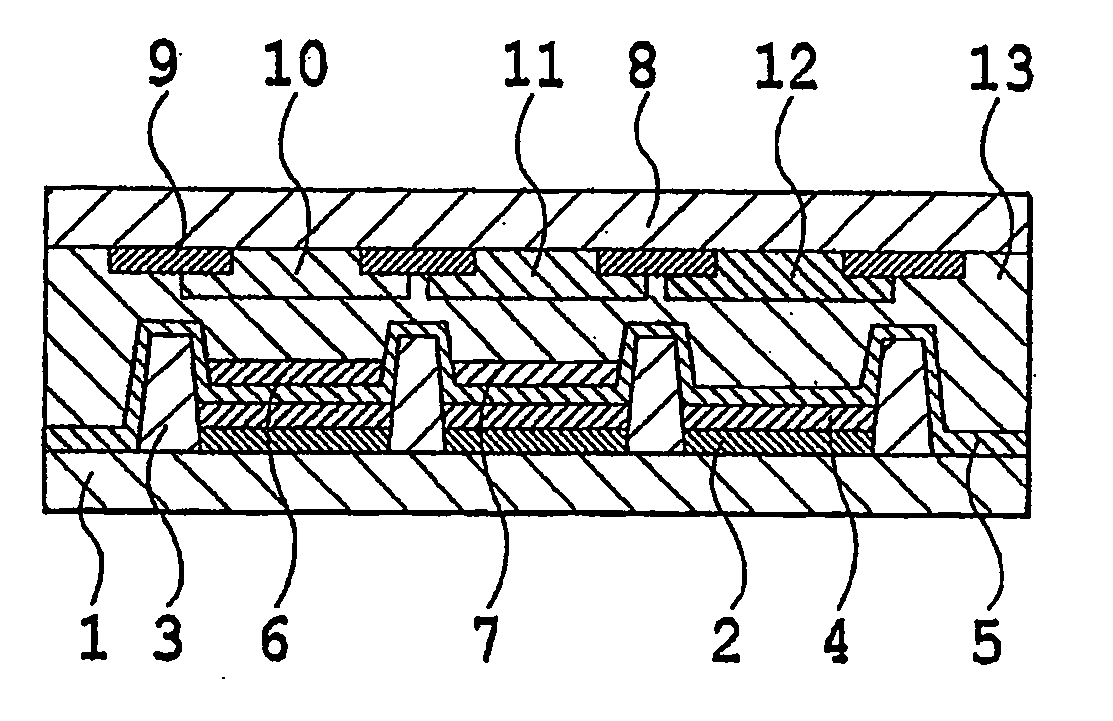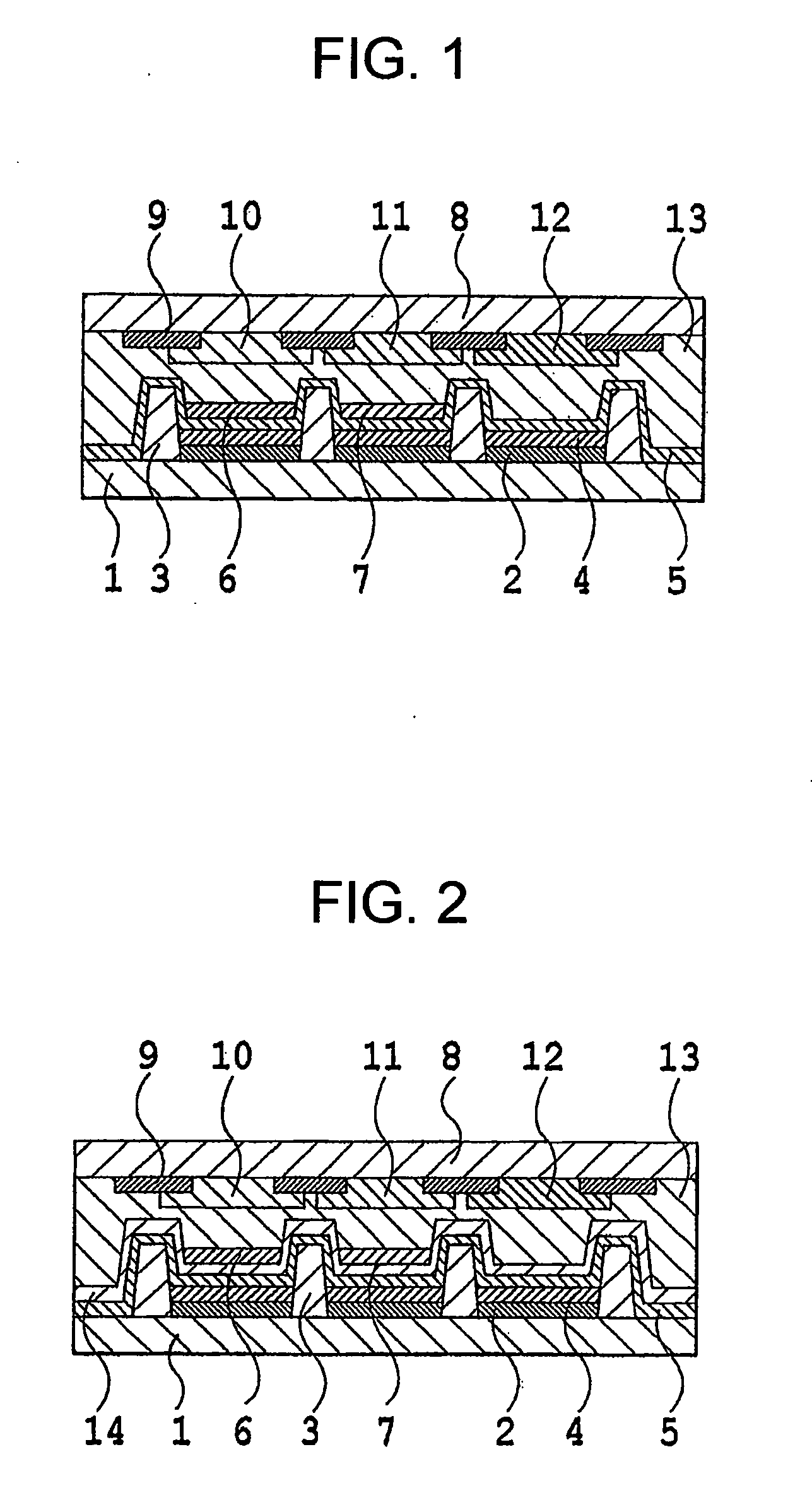Color conversion type organic el display
a technology of organic display and color conversion, applied in the direction of instruments, discharge tubes, luminescent screens, etc., can solve the problems of reducing the absorbance of light to be absorbed, affecting the efficiency of organic display, etc., to achieve the effect of long life and high efficiency
- Summary
- Abstract
- Description
- Claims
- Application Information
AI Technical Summary
Benefits of technology
Problems solved by technology
Method used
Image
Examples
first embodiment
[0027]FIG. 1 is a summary cross-sectional view of the color conversion type organic EL display of a first embodiment of the invention.
[0028](TFT Substrate 1)
[0029]The TFT substrate 1 is a substrate on which is formed a TFT circuit comprising the organic EL display. The uppermost surface of the TFT substrate 1 is covered with an insulating planarization layer, and contact electrodes connected with the TFT circuit, divided into pixel units, are formed. Thereupon is formed a lower reflective electrode, joined with TFTs by contact electrodes, serving as cathodes or as anodes, and separated into pixel units.
[0030]The substrate material may be any insulating material; glass is primarily used, but a polymer material, ceramic, or Si single crystal may also be used without problem.
[0031](Lower Reflective Electrode 2)
[0032]In order to form a top-emission structure organic EL device, a light-reflecting material must be used in the lower reflective electrode 2. Light-reflecting metals which can...
second embodiment
[0066]FIG. 2 is a summary cross-sectional view of the color conversion type organic EL display of a second embodiment of the invention. The color conversion type organic EL display of the second embodiment of the invention has a configuration similar to that of the first embodiment, except for the existence of a transparent protective layer 14 on the upper transparent electrode 5, and the fact that the color conversion layers (6, 7) are formed on the transparent protective layer 14.
[0067](Transparent Protective Layer 14)
[0068]The color conversion layers (6, 7) may be formed directly on the upper transparent electrode 5, but when the method of formation of the color conversion layers (6, 7) is a wet method, if there are pinholes in the upper transparent electrode 5, then intrusion of solvent into the organic EL layer 4 (and in particular the emission layer) is conceivable, and so a transparent protective layer 14 can be inserted on the upper transparent electrode 5.
[0069]As the mater...
example 1
[0070]This example is an example of the first embodiment of the invention. In this example, a substrate which was an alkali-free glass sheet of thickness 0.7 mm, on which was formed a circuit using amorphous Si-TFTs, was used as the TFT substrate 1.
[0071]On the TFT substrate 1, an evaporation deposition method was used to form an Al film of film thickness 100 nm, and a photolithography process was used to perform patterning into pixel region shapes. Specifically, a plurality of partial electrodes, having dimensions 300 μm×100 μm, were formed from the Al film. The gaps between the partial electrodes were 30 μm in the vertical direction and 10 μm in the horizontal direction. Partial electrodes were arranged with 50 in the vertical direction and 150 in the horizontal direction.
[0072]Next, after applying VPA100P5.0, manufactured by Nippon Steel Chemical Co., Ltd., a photolithography method was used to perform patterning, and a bank was formed in the gaps (in the vertical direction and h...
PUM
| Property | Measurement | Unit |
|---|---|---|
| thickness | aaaaa | aaaaa |
| thickness | aaaaa | aaaaa |
| temperature | aaaaa | aaaaa |
Abstract
Description
Claims
Application Information
 Login to View More
Login to View More - R&D
- Intellectual Property
- Life Sciences
- Materials
- Tech Scout
- Unparalleled Data Quality
- Higher Quality Content
- 60% Fewer Hallucinations
Browse by: Latest US Patents, China's latest patents, Technical Efficacy Thesaurus, Application Domain, Technology Topic, Popular Technical Reports.
© 2025 PatSnap. All rights reserved.Legal|Privacy policy|Modern Slavery Act Transparency Statement|Sitemap|About US| Contact US: help@patsnap.com


